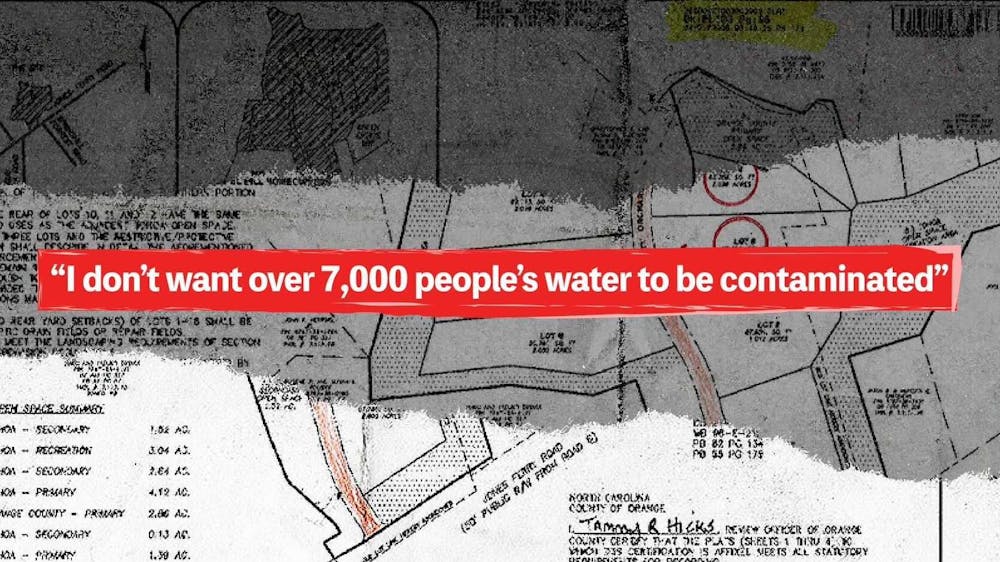Smith said a number of elderly residents found the project attractive because they have watched taxes and property values rise over the years and thought Buc-ee's would bring back businesses to the area.
While other development is coming to the area, like a Medline Industries manufacturing facility, Buc-ee’s would have offered services some residents felt they couldn't get elsewhere in the area.
Opponents to the project, however, were organized and vocal about the environmental and social hazards of the project. Given the station’s proximity to the protected watershed, many residents were concerned the quantities of gas stored underground posed a threat to the drinking water of communities downstream, particularly Hillsborough.
“I don’t want a Buc-ee’s two miles away from my home, but more importantly I don’t want over 7,000 people’s water to be contaminated,” Ward said.
After speaking against the project at an Orange County Planning Board meeting last fall, Ward joined voices with other Efland residents who had started A Voice for Efland & Orange, an organization focused on raising awareness about the project.
Smith also had concerns that subsequent development would have had the potential to displace residents with deep familial roots in Efland, forcing them to sell their properties at low values to move to more affordable areas.
A Voice for Efland and Orange mobilized residents at planning board and county commissioner meetings. Vocal supporters were far less numerous, and the debate sowed doubt among the developers and county commissioners. Buc-ee’s ultimately decided to withdraw its application before the BOCC could vote on it, stating that the county was not receptive to the project.
Building trust, moving forward
Jared Cates, an Efland resident, and organizer for A Voice for Efland & Orange said while the group opposed Buc-ee’s, it understands the need for development in the county.
“I think we’re all passionate community folks who want to see how we can put pressure now moving forward to see development that will benefit all of us,” he said.
Four in 10 residents of Efland are Black and the area, as the homeland of various Siouan-speaking peoples, has a rich Indigenous history.
Smith, a Black woman, said her family and many others have deep generational roots in Efland. There was a lack of trust between some Black residents and other actors, including the county government and A Voice for Efland and Orange, many of those involved being white and more recent arrivals to Efland.
To get the day's news and headlines in your inbox each morning, sign up for our email newsletters.
Cates agreed the organization failed to adequately build trust between communities regarding the Buc-ee’s station, even though one of their primary concerns was the negative impacts of the development on marginalized communities.
Smith said she thought the polarization around the project was "baffling", and the community cast blame upon Black residents for not vocalizing their support. But she said the lack of vocalization was due to a history of fear.
“When I have conversations with the people who were for it and the people who were against it, they do have a commonality of wanting to see development,” she said.
Smith said the community needs to create space for conversation and learn to be better listeners.
Crystal Cavalier, an Indigenous water protector, land defender, and citizen of the Occaneechi Band of the Saponi Nation, wrote a letter to the BOCC in early February to voice her opposition to Buc-ee's.
“Our county commissioners are elected to represent us and they have a duty to protect the water,” she said.
Although she was able to make her voice heard in working with other activists like Cates, she agreed moving forward, the county needs to forge stronger relationships with Indigenous communities, marginalized communities, and citizens in general.
Ward said the overwhelming majority of people he spoke to about the project were unaware of it, indicative of what he described as an attempt to keep people uninformed to secure the rezoning permit. Though he sympathizes with supporters who sought development, Buc-ee’s was far from an ideal option.
“We didn’t miss an opportunity, we avoided a disaster,” he said.
However, he said the issue exposed flaws in the bureaucratic process surrounding development and that bad faith actors pushed the project through a lack of information.
A representative from Buc-ee’s declined to comment for this story.
“If we can’t address that, then we’re just going to keep getting developments like Buc-ee’s that we’re going to have to keep fighting,” Ward said.
What’s next?
Before more projects come to Orange County, many residents want to see greater involvement and dialogue with the communities so that future development does not endanger the environment and is aligned with the county’s environmental and social goals.
Cavalier said a civilian task force is essential to determine what comes next for Orange County’s development. Beyond that, she wants to see an effort to revitalize sustainable agriculture and other ventures that would build community resilience and be ecologically sound.
In Smith's eyes, the best development would entail projects that are sustainable and encourage young people to stay in the area.
Cates expressed an interest in revitalizing the Efland-Mebane Small Area Plan, a discontinued economic area study from the mid-2000s that included a task force with representatives from the two communities.
The Buckhorn Area Plan is a similar economic study along the I-40/85 corridor that will assess land-use changes and long-term economic development in areas between Orange and Alamance counties.
Ward said next on A Voice for Efland and Orange’s agenda is to get involved in the discourse around the Buckhorn Area Plan.
“We’re not planning on going away anytime soon,” he said.
@HenryHaney17
@DTHCityState | city@dailytarheel.com



